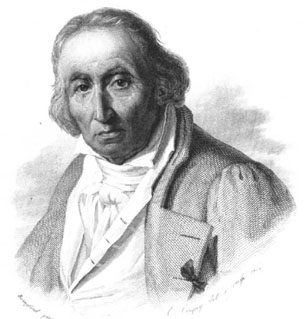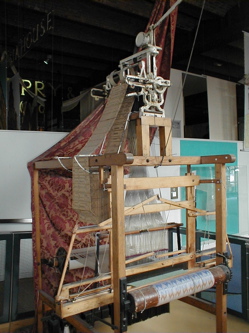 |
| Joseph-Marie Jacquard |
Joseph-Marie Jacquard was born in Lyon, France in 1752 to a family of weavers. At the time, weaving the fine cloths in demand around the world was a tedious process that had been done by hand for generations. When Jacquard inherited his family's business, he realized that the labor cost of weaving the fabrics more or less destroyed any profit he could hope to make.
The profit was so minuscule on weaving, in fact, that Jacquard worked a separate job in a factory to make ends meet for a time. He began developing what would become the Jacquard loom prior to the French Revolution, during which time progress on the invention was stalled long enough to prevent the patent from being filed until 1804. The French government, realizing how important the Jacquard loom was, declared Jacquard's invention public property and assigned him a government pension and a set royalty on every machine produced. This seizure of the patent happened in 1806, two years after the patent was filed, and five years after Jacquard exhibited the loom in Paris.
 |
| The cantilever loom, an example of the looms in common use prior to the Jacquard loom. (Image from the Colonial Williamsburg website) |
This process was prone to error, which was a two-fold reason for Jacquard to automate the weaving process. This isn't to say that other inventors hadn't already attempted the same thing Jacquard succeeded at. Fellow Lyon native Basile Bouchon developed a way to control a loom using punched paper tape similar to a organ in 1725; three years later, his assistant Jean-Baptiste Falcon made some improvements to the machine.
The year 1745 saw Jacques de Vaucanson (a renowned builder of automatons) developing a system of further automating the process in Bouchon's design. De Vaucanson's designs were ignored in his lifetime, however, and he died without the loom ever being fully produced.
An Anglican priest stationed at the cathedral in Lincolnshire, Edmund Cartwright, developed the power loom in 1784. The design had numerous flaws though, and it would take 40 years and several patented designs -- including in 1789 and 1792 -- before all the issues with the loom's function were resolved.
Regardless of the innovations that came before, the Jacquard loom was the first to make consistent and effective use of a punch card system to automate the weaving process. The loom was initially opposed by silk weavers throughout France; the weavers were under the impression that the Jacquard loom's automation would make them redundant, thus eliminating an entire cottage industry.
 |
| Jacquard loom on display at the Manchester Museum of Science and Industry. Photo taken by George H. Williams in July 2004. |
The function of the loom itself is striking in its simplicity. A roll of punched cards is placed in the feeder, which runs beneath the hooks in the loom. The hooks remain in place until a hole in the punched card passes by, and then move into action pressing another thread into place. From Wikipedia:
Each hole in the card corresponds to a "Bolus" hook, which can either be up or down. The hook raises or lowers the harness, which carries and guides the warp thread so that the weft will either lie above or below it. The sequence of raised and lowered threads is what creates the pattern. Each hook can be connected via the harness to a number of threads, allowing more than one repeat of a pattern. A loom with a 400-hook head might have four threads connected to each hook, resulting in a fabric that is 1600 warp ends wide with four repeats of the weave going across.The heavy card-stock common to punched cards was first developed because of the Jacquard loom; high-volume Jacquard looms even made use of metal cards so they programs wouldn't fall to pieces after excessive use. A very interesting facet of the Jacquard loom that makes it distinct among machines using punched cards is the fact that the cards themselves are strung together and fed along a cylinder rather than being placed through the machine one at a time.
 | ||
| Close-up view of the 8 × 26 hole punched cards— one card per pick (weft) in the fabric. (Wikipedia) |
As more Jacquard looms were built and sent to factories throughout Europe, more designs were programmed into the punched card system, and fabric became cheaper and cheaper to weave. The errors of the pre-Jacquard loom weaving industry could be said to have almost disappeared, and the lack of profit one could expect from becoming a weaver also slowly diminished. If a single man could weave 10 yards of cloth in the time it used to take him to weave one or two, then the Jacquard loom already made its mark in the economics of the Industrial Revolution.
As for the history of computers, the success of the Jacquard loom is what led Charles Babbage to develop his Engines in the 1820s and 1830s based on the punched-card model. In fact, Babbage's punched cards were also attached to one another by small straps, similar to the way the punched cards of the Jacquard loom were attached to one another. It wouldn't be until Herman Hollerith developed his punched cards for the 1890 U.S. Census that individual punched cards came around into popular use.
That the Jacquard loom is a Steampunk device is in little doubt. Mechanical computer? Check. Punched card system set in a language of 0 (no hole) and 1 (hole)? Check. Possibility to have mechanized looms clacking along while steam power sends the flying shuttle whizzing back and forth through the mechanism? Check. Already the possibilities for a scene in a Steampunk textile factory are very interesting. But that's just my view.

4 comments:
And of course, we know Ada Lovelace's first computer program, on punch cards, was an idea borrowed from the Jacquard Loom!
Mm-hmm ... that Ada Lovelace was one smart cookie, she was.
And what's even more fascinating to me is the fact that someone had to produce the pattern on the punch card long before inserting it into the loom.
Now, how do you come up with something like that?
.......dhole
Matt, I'm pretty sure you could take all of these awesome posts and turn them into a book. The information is like, whoa man.
Post a Comment